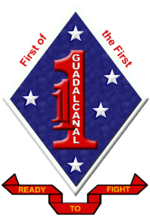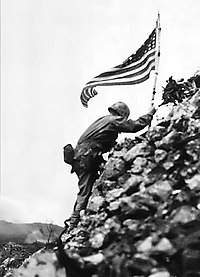
2d Battalion 5th Marines is an infantry battalion in the United States Marine Corps consisting of approximately 800 Marines and Sailors. They are based out of Marine Corps Base Camp Pendleton, California and fall under the command of the 5th Marine Regiment and the 1st Marine Division. The battalion has seen combat in World War I, World War II, the Korean War, the Vietnam War and the Gulf War and has deployed many times in support of Operation Iraqi Freedom and the current War on Terror.

3rd Battalion 1st Marines (3/1) is an infantry battalion in the United States Marine Corps based out of Camp Horno on Marine Corps Base Camp Pendleton, California. Nicknamed the "Thundering Third", the battalion consists of approximately 1,220 Marines and Sailors and falls under the command of the 1st Marine Regiment and the 1st Marine Division.

2nd Light Armored Reconnaissance Battalion is a fast and mobilized armored terrestrial reconnaissance battalion of the United States Marine Corps. Their primary weapon system is the 8-wheeled LAV-25 and they fall under the command of the 2nd Marine Division and II Marine Expeditionary Force. The unit is based out of the Marine Corps Base Camp Lejeune, North Carolina. The current mission statement of the battalion is: To perform combined arms reconnaissance and security missions in support of the Ground Combat Element (GCE) of a Marine Air-Ground Task Force (MAGTF). Its mission is to conduct reconnaissance, security and economy of force operations, and, within its capabilities, limited offensive or defensive operations that exploit the unit's mobility and firepower.
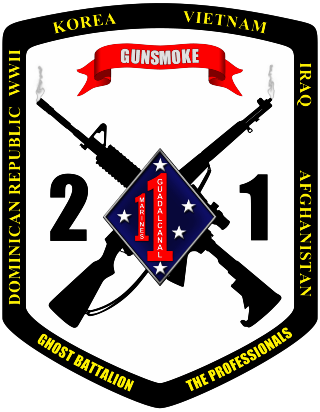
2nd Battalion, 1st Marines (2/1) is an infantry battalion in the United States Marine Corps based in Camp Horno on Marine Corps Base Camp Pendleton, California. Nicknamed "The Professionals," the battalion consists of approximately 1,200 Marines and Sailors. Normally they fall under the command of the 1st Marine Regiment and the 1st Marine Division.
Radio Battalions are tactical signals intelligence units of Marine Corps Intelligence. There are currently three operational Radio Battalions in the Marine Corps organization: 1st, 2nd, and 3rd. In fleet operations, teams from Radio Battalions are most often attached to the command element of Marine Expeditionary Units.

1st Battalion, 5th Marines (1/5) is an infantry battalion in the United States Marine Corps based out of Marine Corps Base Camp Pendleton, California consisting of approximately 800 Marines and sailors. Nicknamed Geronimo, it falls under the command of the 5th Marine Regiment and the 1st Marine Division. The battalion was formed in 1914 and has served in every major conflict that the United States has been involved in since then.

The 3rd Reconnaissance Battalion conducts amphibious and ground reconnaissance in support of the 3rd Marine Division and Marine Forces Pacific (MarForPac), operating in the commander's areas of influence. The Battalion is based out of Camp Schwab, a satellite base of Marine Corps Base Camp Smedley D. Butler. It is geographically located on the Okinawa Prefecture in Japan.

1st Battalion, 3rd Marines (1/3) is an infantry battalion in the United States Marine Corps based out of Marine Corps Base Hawaii. Nicknamed the "Lava Dogs", the battalion consists of approximately 800 Marines and sailors and falls under the command of the 3rd Marine Regiment of the 3rd Marine Division.

2nd Battalion, 3rd Marines (2/3) was an infantry battalion in the United States Marine Corps based out of Marine Corps Base Hawaii consisting of approximately 1,000 Marines and sailors. The battalion fell under the command of the 3rd Marine Regiment and the 3rd Marine Division. The battalion was deactivated in January 2022 as part of the Marine Corps' ongoing Force Design efforts.

2nd Battalion of the 11th Marines ("Patriot") is an artillery battalion comprising three firing batteries and a Headquarters Battery. The battalion is stationed at Marine Corps Base Camp Pendleton, California. Its primary weapon system is the M777 lightweight howitzer. The battalion was the first in the Marine Corps to fully transition from the M198 Howitzer. They fall under the command of the 11th Marine Regiment and the 1st Marine Division.

5th Battalion 11th Marines (5/11) is a High Mobility Artillery Rocket System (HIMARS) battalion consisting of four Firing Batteries and a Headquarters Battery. The battalion is stationed at Marine Corps Base Camp Pendleton, California. It is the first active duty HIMARS Unit in the Marine Corps. They fall under the command of the 11th Marine Regiment and the 1st Marine Division. This is the only battalion in the 11th Marine Regiment not using the M777A2 lightweight howitzer.
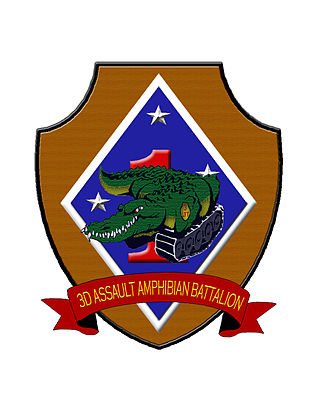
3rd Assault Amphibian Battalion is one of two active duty assault amphibian battalions in the United States Marine Corps. The battalion's primary weapon system is the Amphibious Assault Vehicle or AAV. The AAV is a 27.5-ton armored vehicle that carries up to 21 combat-loaded Marines and is armed with the UGWS, which mounts a .50 cal (12.7 mm) M2HB machine gun and a Mk-19 40 mm grenade launcher. The battalion is also equipped with the Amphibious Combat Vehicle or ACV, a rather new variant to the USMC’s amphibious armament which will replace the AAV in years to come. The AAV ACV are the only armored vehicles in the U.S. inventory that are fully capable of operations both on land and in the ocean. The battalion is part of the 1st Marine Division and the I Marine Expeditionary Force. The unit is based in Camp Pendleton, California.

3rd Battalion, 24th Marines (3/24) was a reserve infantry battalion in the United States Marine Corps. The battalion was first formed in 1943 for service in the Pacific Theater of Operations during World War II, taking part in a number of significant battles including those at Saipan and Iwo Jima before being deactivated at the end of the war. In the early 1960s, the unit was reactivated as a reserve battalion. It was located throughout the Midwestern United States and consisted of approximately 800 Marines and Sailors. The battalion was part of the 24th Marine Regiment and the 4th Marine Division. Recent operations included tours in Iraq and Afghanistan. On May 19, 2013, the battalion was deactivated (retired) as a part of 2013 Marine Corps Force Restructuring, along with the 24th Marine Regiment. 3/24 personnel were reallocated to 23rd Marine Regiment, with the majority of the companies becoming 3rd Battalion, 23rd Marines.

The 1st Battalion 9th Marines (1/9) was an infantry battalion of the United States Marine Corps. Formed during World War I, it served until the mid-2000s when it was deactivated to make room for one of three light armor reconnaissance battalions. During the Vietnam War, 1/9 sustained an especially high casualty rate, such that it received the nickname "The Walking Dead".

The 7th Engineer Support Battalion is an engineering support unit of the United States Marine Corps and is headquartered at Marine Corps Base Camp Pendleton, California. The unit falls under the command of 1st Marine Logistics Group and the I Marine Expeditionary Force.

2nd Assault Amphibian Battalion is a mechanized battalion of the United States Marine Corps. Their primary weapon system is the Amphibious Assault Vehicle. The battalion is a separate battalion within the 2nd Marine Division and the II Marine Expeditionary Force. The unit is based out of the Camp Lejeune, North Carolina

The 15th Marine Expeditionary Unit is one of seven such units currently in existence in the United States Marine Corps. The Marine Expeditionary Unit (MEU) is a Marine Air Ground Task Force (MAGTF) with a strength of about 2,200 personnel. The MEU consists of a command element, a reinforced infantry battalion, a composite helicopter squadron and a combat logistics battalion. The 15th MEU is currently based out of Marine Corps Base Camp Pendleton, California.

The United States Marine Corps is organized within the Department of the Navy, which is led by the Secretary of the Navy (SECNAV). The most senior Marine commissioned officer is the Commandant of the Marine Corps, responsible for organizing, recruiting, training, and equipping the Marine Corps so that it is ready for operation under the command of the unified combatant commanders. The Marine Corps is organized into four principal subdivisions: Headquarters Marine Corps, the Operating Forces, the Supporting Establishment, and the Marine Forces Reserve.
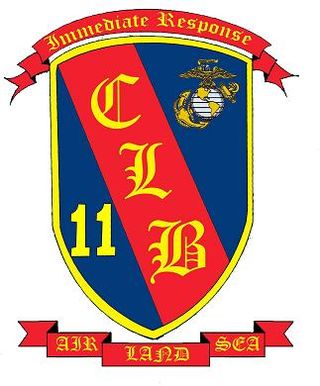
Combat Logistics Battalion 11 (CLB-11) is a logistics battalion of the United States Marine Corps. When not deployed they are part of Headquarters Regiment, 1st Marine Logistics Group. The unit is based out of the Marine Corps Base Camp Pendleton, California and when deployed provides combat logistical support to the 11th Marine Expeditionary Unit.

1st Force Reconnaissance Company conducts deep reconnaissance and direct action raids in support of I Marine Expeditionary Force requirements across the range of military operations to include crisis response, expeditionary operations and major combat operations. 1st Force Recon Company was deactivated 26 October 2006 and the majority of the personnel were used to create 1st Marine Special Operations Battalion.
